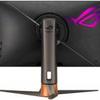The On-Screen Display
The On-Screen Display
Asus has equipped the monitor with a range of on-screen menu options, including sRGB and Wide Color Gamut modes, precise color temperature and gamma modes, and six-axis color calibration. While the PG27AQN is primarily intended for gaming, these features make it suitable for content creation purposes as well.
Upon pressing the control joystick, a preliminary menu with helpful tips appears on the screen. In addition, two physical keys provide quick selection among GameVisual modes and GamePlus functions, while allowing quick access to a wide range of monitor functions. Asus monitors have long been commended for their high level of ease of use, menu speed, and logic of construction. The OSD appearance corresponds to the updated ROG Swift concept and is similar to the top-end PG32UQX with a Mini-LED backlight. The new model contains eight sections with somewhat revised content.
The initial menu screen is dedicated to activating and configuring the NVIDIA Reflex Analyzer. Users can activate the analyzer, adjust the display sensitivity, and change the size and location of the measured area, which is a green rectangle that monitors the change in pixel color, such as measuring the muzzle flash during a shot from a weapon.The second screen, called “Gaming,” allows users to set the degree of matrix overclocking (OD), configure GamePlus functions, select one of the GameVisual modes, and set the degree of shadow highlighting (Dark Boost).
The second tab section of the monitor settings allows you to make adjustments to the brightness and contrast levels, choose the HDR mode (which only appears when enabled in the OS environment), and enable and configure dynamic backlighting (which has several color options but no separate brightness control zone, making it an analogue of Dynamic Contrast ACR. Additionally, you can choose the operating mode of the built-in scaler (which includes the Esports Dual-Mode), and adjust the level of blue light filtering on the screen. Instead of the sRGB color space emulation mode, there is a Display Color Space function that lets you choose between the full color gamut and sRGB, and this function is active in all modes.
The fourth section, labelled "Color," is also important and features color temperature modes, manual RGB gain level adjustments, five gamma modes, and the option to adjust saturation (which may not always be available). It also includes a built-in signal compression system to support high frequencies when using older graphics cards, assuming you have the appropriate hardware.
In the Input Select section, you can choose the signal source and enable automatic source search. The Shortcut section allows for the selection of shortcut functions for two physical keys, with a wide range of options and individual user preferences.
Finally, the fifth section, "Lighting Effect," offers the ability to enable and adjust the colourful Aura RGB lighting effect, as well as the option to enable Aura Sync if needed. The System Setup section comprises parameters generally not associated with the visual output quality. It offers several options, such as customizing the OSD menu's appearance and position, choosing the preferred language for menu localization, restricting access to control buttons, and disabling the power indicator.
Additionally, there is a subcategory that provides basic operational information, including the option to enable the ambient light sensor without any further customization, disabling pop-up warnings when transitioning to HDR mode, adjusting volume levels, and selecting one of the power-saving modes when the monitor is in standby mode.







